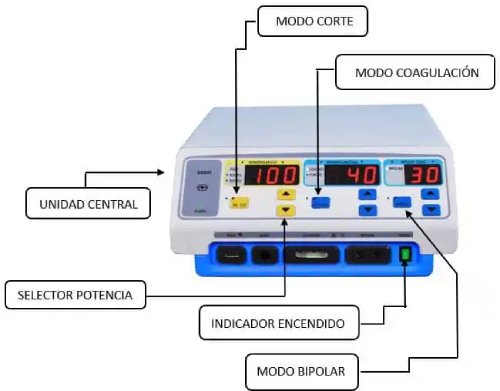Electrocauteriozation, often referred to as electrocauterio, is a surgical technique that utilizes electricity to achieve two primary purposes:
- Tissue cutting: The electrical current heats tissue enough to cause its vaporization, allowing for precise incisions with minimal bleeding.
- Blood vessel sealing: By applying focused heat, electrocautery seals blood vessels, minimizing blood loss during surgery.
This article delves into the world of electrocautery, explaining its applications, benefits, safety considerations, and frequently asked questions.
Components of an Electrocauterio Unit
An electrocauterization unit comprises several key components:
- Generator: This device produces the electrical current used in the procedure. Modern generators offer adjustable power settings for different tissue types and desired effects.
- Active electrode: This hand-held instrument comes in various shapes and sizes depending on the intended use. It directly contacts the tissue and delivers the electrical current. Common examples include probes, needles, and loop electrodes.
- Return electrode pad: Placed on the patient’s body, typically on the thigh or back, this pad completes the electrical circuit.
Applications of Electrocauterio
Electrocauterization finds application in a wide range of surgical procedures, including:
- General surgery: Used for precise dissection of tissues, minimizing blood loss during open abdominal, thoracic, and other general surgical procedures.
- Laparoscopic surgery: Plays a crucial role in minimally invasive surgeries by allowing for tissue cutting, dissection, and blood vessel sealing within the confined laparoscopic space.
- Gynecology: Employed in procedures like hysterectomy (removal of the uterus) and myomectomy (removal of uterine fibroids) for precise tissue manipulation and blood vessel control.
- Urology: Used in surgeries like prostate removal and bladder procedures for efficient tissue cutting and hemostasis (bleeding control).
- Otolaryngology (ENT): Helpful in procedures like tonsillectomy (removal of tonsils) and nasal surgery by providing a clear operating field and minimizing blood loss.
- Dermatology: Used for removal of skin lesions like warts, moles, and skin tags with minimal scarring.
Benefits of Electrocauterio
Electrocauterio offers several advantages over traditional surgical techniques:
- Reduced blood loss: By sealing blood vessels as they are cut, electrocauterio significantly minimizes blood loss during surgery, improving surgical visibility and patient safety.
- Precise tissue dissection: The focused application of heat allows for controlled and precise cutting of tissues, minimizing damage to surrounding structures.
- Faster procedures: Electrocauterio can expedite surgeries by minimizing bleeding and facilitating efficient tissue manipulation.
- Sterilization effect: The high temperature generated during electrocauterio has a sterilizing effect on the surgical site, reducing the risk of infection.
Safety Considerations with Electrocauterio
While a valuable surgical tool, electrocauterio use requires careful attention to safety:
- Tissue damage: Inappropriate use can lead to unintended thermal injury to surrounding tissues.
- Burns: Improper placement of the return electrode pad can result in burns on the patient’s skin.
- Smoke plume: The vaporization of tissue during electrocauterio creates a plume of smoke that may contain harmful byproducts. Proper smoke evacuation is essential.
- Electrical hazards: Faulty equipment or improper grounding poses electrical risks to both patients and healthcare personnel.
How to Prepare for Electrocauterio Surgery
If you are scheduled for a procedure involving electrocauterio, here’s what to expect:
- Pre-operative consultation: Your doctor will discuss the details of the surgery, including the use of electrocauterio and any potential risks.
- Medical history review: Inform your doctor about any medical conditions you have, particularly those related to bleeding or implanted devices like pacemakers.
- Medication adjustments: Certain medications may need to be adjusted before surgery to minimize bleeding risks.
Electrocauterio FAQs
- Will I feel pain during electrocauterio?
You will not feel pain during the procedure itself as you will be under anesthesia. However, you may experience some discomfort or burning after the surgery as the treated area heals.
- Are there any side effects associated with electrocauterio?
Possible side effects include temporary pain, swelling, and bruising at the surgical site. In rare cases, there may be a risk of infection or nerve damage.
- Is electrocauterio safe for everyone?
Electrocauterio is generally safe, but it may not be suitable for individuals with certain medical conditions, such as those with pacemakers or implanted defibrillators. Your doctor will assess your individual situation to determine if electrocautery is the right choice for you.
- What are the advantages of electrocauterio over traditional surgical techniques?
Electrocauterio offers several advantages, including:
- Reduced blood loss
- Precise tissue dissection
- Faster procedures
- Sterilization effect
Conclusion
Electrocauterio is a versatile and valuable tool in a surgeon’s arsenal. It offers numerous benefits for both patients and surgeons, including reduced blood loss, precise tissue control, and faster procedures. However, careful attention to safety protocols is crucial to minimize potential complications. If you are scheduled for a surgery involving electrocautery, discuss any concerns you may have with your doctor beforehand. They will explain the details of the procedure and address any questions you might have.
